Royal Commission and Banking Sector in Australia: An Essay
VerifiedAdded on 2020/05/28
|13
|3570
|52
Essay
AI Summary
This essay examines the Australian banking and finance industry, highlighting its significant contribution to the country's GDP and employment. It explores the recent challenges faced by the sector, including misconduct, unethical practices, and the influence of an oligopolistic market structure dominated by the 'Big Four' banks. The essay delves into specific problems such as money laundering, misleading financial advice, and forgery, which have led to a loss of credibility and the proposal for a Royal Commission. The scope of the Royal Commission, its responsibilities, and potential limitations are discussed, along with recommendations for addressing the identified issues. The essay underscores the need for reform and an unbiased investigation to restore trust and improve the welfare of stakeholders within the financial sector.
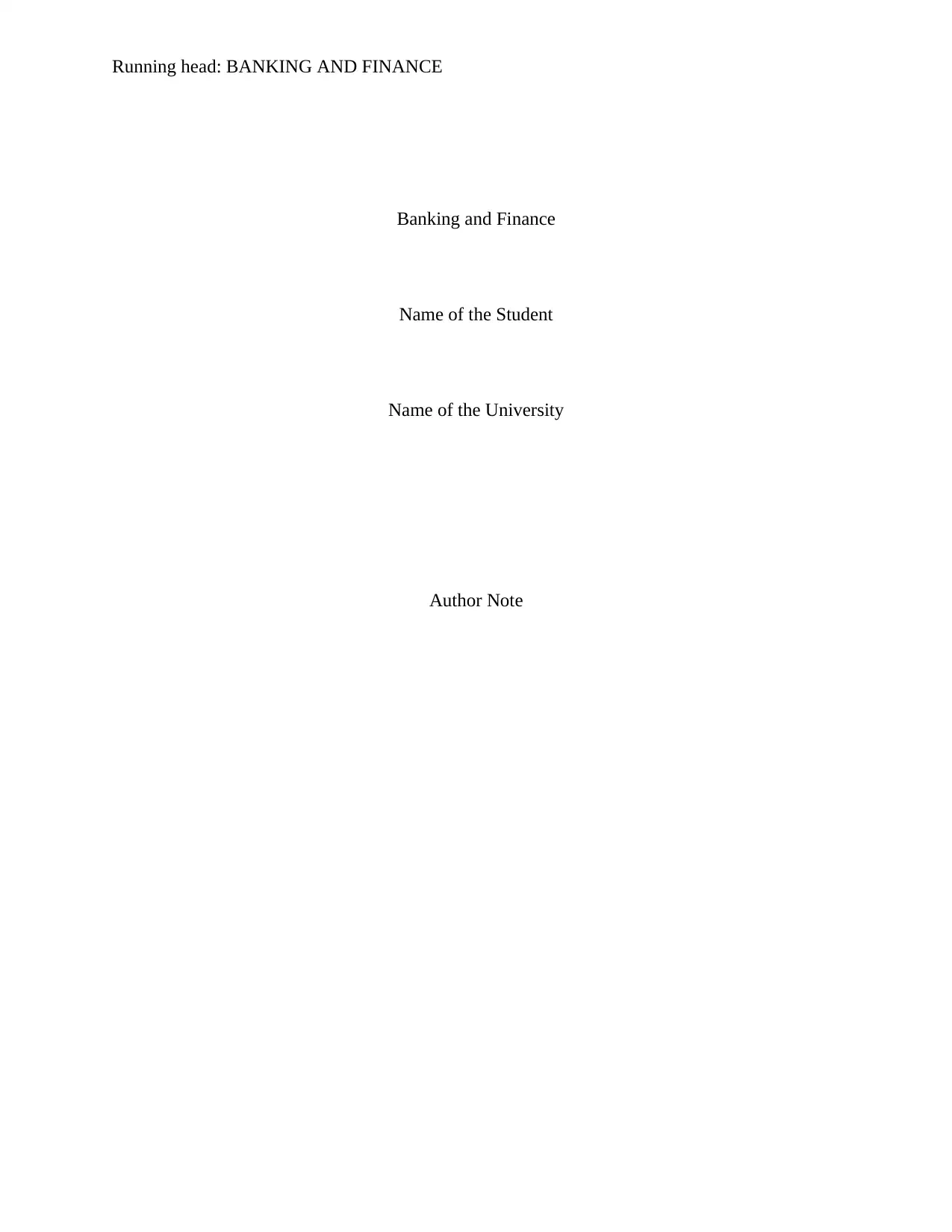
Running head: BANKING AND FINANCE
Banking and Finance
Name of the Student
Name of the University
Author Note
Banking and Finance
Name of the Student
Name of the University
Author Note
Paraphrase This Document
Need a fresh take? Get an instant paraphrase of this document with our AI Paraphraser
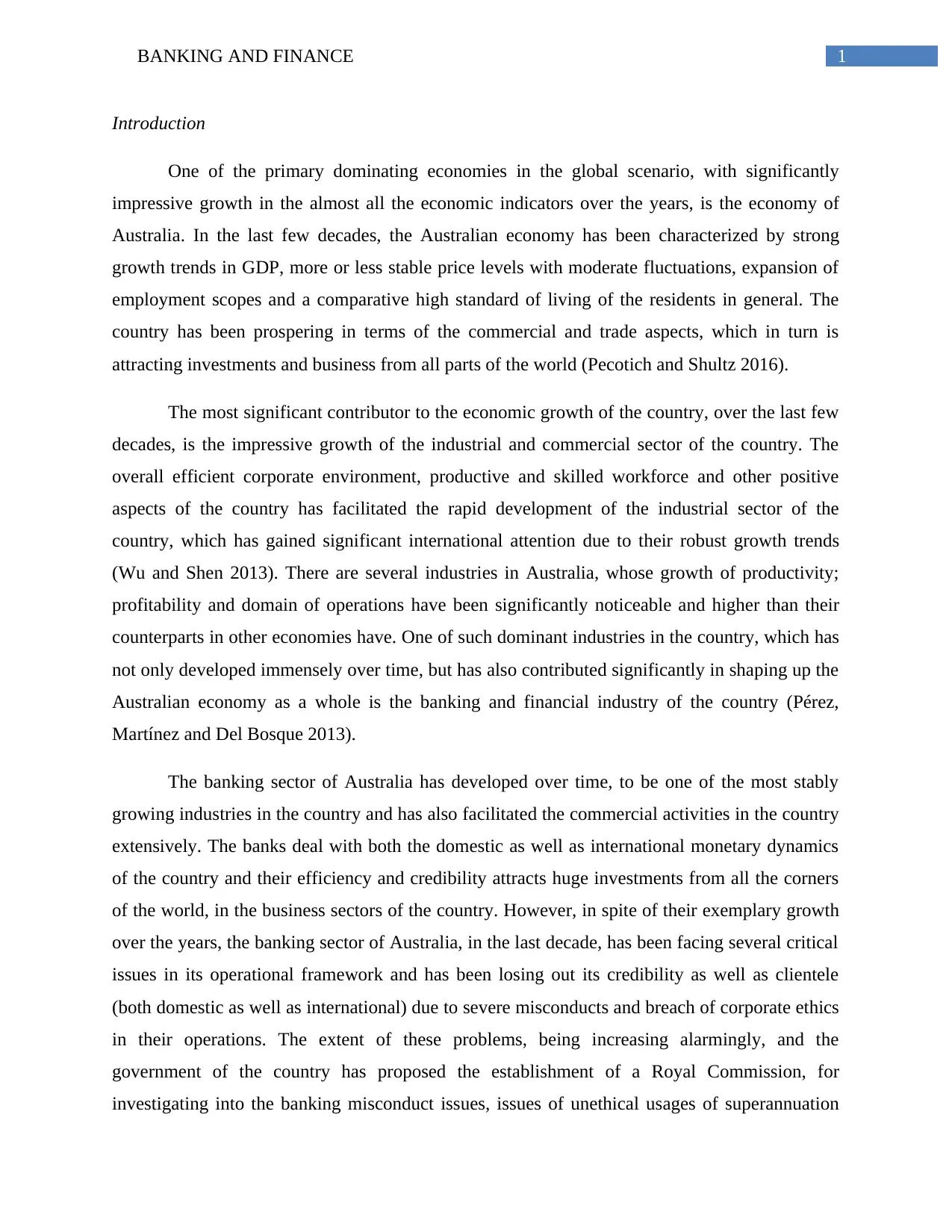
1BANKING AND FINANCE
Introduction
One of the primary dominating economies in the global scenario, with significantly
impressive growth in the almost all the economic indicators over the years, is the economy of
Australia. In the last few decades, the Australian economy has been characterized by strong
growth trends in GDP, more or less stable price levels with moderate fluctuations, expansion of
employment scopes and a comparative high standard of living of the residents in general. The
country has been prospering in terms of the commercial and trade aspects, which in turn is
attracting investments and business from all parts of the world (Pecotich and Shultz 2016).
The most significant contributor to the economic growth of the country, over the last few
decades, is the impressive growth of the industrial and commercial sector of the country. The
overall efficient corporate environment, productive and skilled workforce and other positive
aspects of the country has facilitated the rapid development of the industrial sector of the
country, which has gained significant international attention due to their robust growth trends
(Wu and Shen 2013). There are several industries in Australia, whose growth of productivity;
profitability and domain of operations have been significantly noticeable and higher than their
counterparts in other economies have. One of such dominant industries in the country, which has
not only developed immensely over time, but has also contributed significantly in shaping up the
Australian economy as a whole is the banking and financial industry of the country (Pérez,
Martínez and Del Bosque 2013).
The banking sector of Australia has developed over time, to be one of the most stably
growing industries in the country and has also facilitated the commercial activities in the country
extensively. The banks deal with both the domestic as well as international monetary dynamics
of the country and their efficiency and credibility attracts huge investments from all the corners
of the world, in the business sectors of the country. However, in spite of their exemplary growth
over the years, the banking sector of Australia, in the last decade, has been facing several critical
issues in its operational framework and has been losing out its credibility as well as clientele
(both domestic as well as international) due to severe misconducts and breach of corporate ethics
in their operations. The extent of these problems, being increasing alarmingly, and the
government of the country has proposed the establishment of a Royal Commission, for
investigating into the banking misconduct issues, issues of unethical usages of superannuation
Introduction
One of the primary dominating economies in the global scenario, with significantly
impressive growth in the almost all the economic indicators over the years, is the economy of
Australia. In the last few decades, the Australian economy has been characterized by strong
growth trends in GDP, more or less stable price levels with moderate fluctuations, expansion of
employment scopes and a comparative high standard of living of the residents in general. The
country has been prospering in terms of the commercial and trade aspects, which in turn is
attracting investments and business from all parts of the world (Pecotich and Shultz 2016).
The most significant contributor to the economic growth of the country, over the last few
decades, is the impressive growth of the industrial and commercial sector of the country. The
overall efficient corporate environment, productive and skilled workforce and other positive
aspects of the country has facilitated the rapid development of the industrial sector of the
country, which has gained significant international attention due to their robust growth trends
(Wu and Shen 2013). There are several industries in Australia, whose growth of productivity;
profitability and domain of operations have been significantly noticeable and higher than their
counterparts in other economies have. One of such dominant industries in the country, which has
not only developed immensely over time, but has also contributed significantly in shaping up the
Australian economy as a whole is the banking and financial industry of the country (Pérez,
Martínez and Del Bosque 2013).
The banking sector of Australia has developed over time, to be one of the most stably
growing industries in the country and has also facilitated the commercial activities in the country
extensively. The banks deal with both the domestic as well as international monetary dynamics
of the country and their efficiency and credibility attracts huge investments from all the corners
of the world, in the business sectors of the country. However, in spite of their exemplary growth
over the years, the banking sector of Australia, in the last decade, has been facing several critical
issues in its operational framework and has been losing out its credibility as well as clientele
(both domestic as well as international) due to severe misconducts and breach of corporate ethics
in their operations. The extent of these problems, being increasing alarmingly, and the
government of the country has proposed the establishment of a Royal Commission, for
investigating into the banking misconduct issues, issues of unethical usages of superannuation
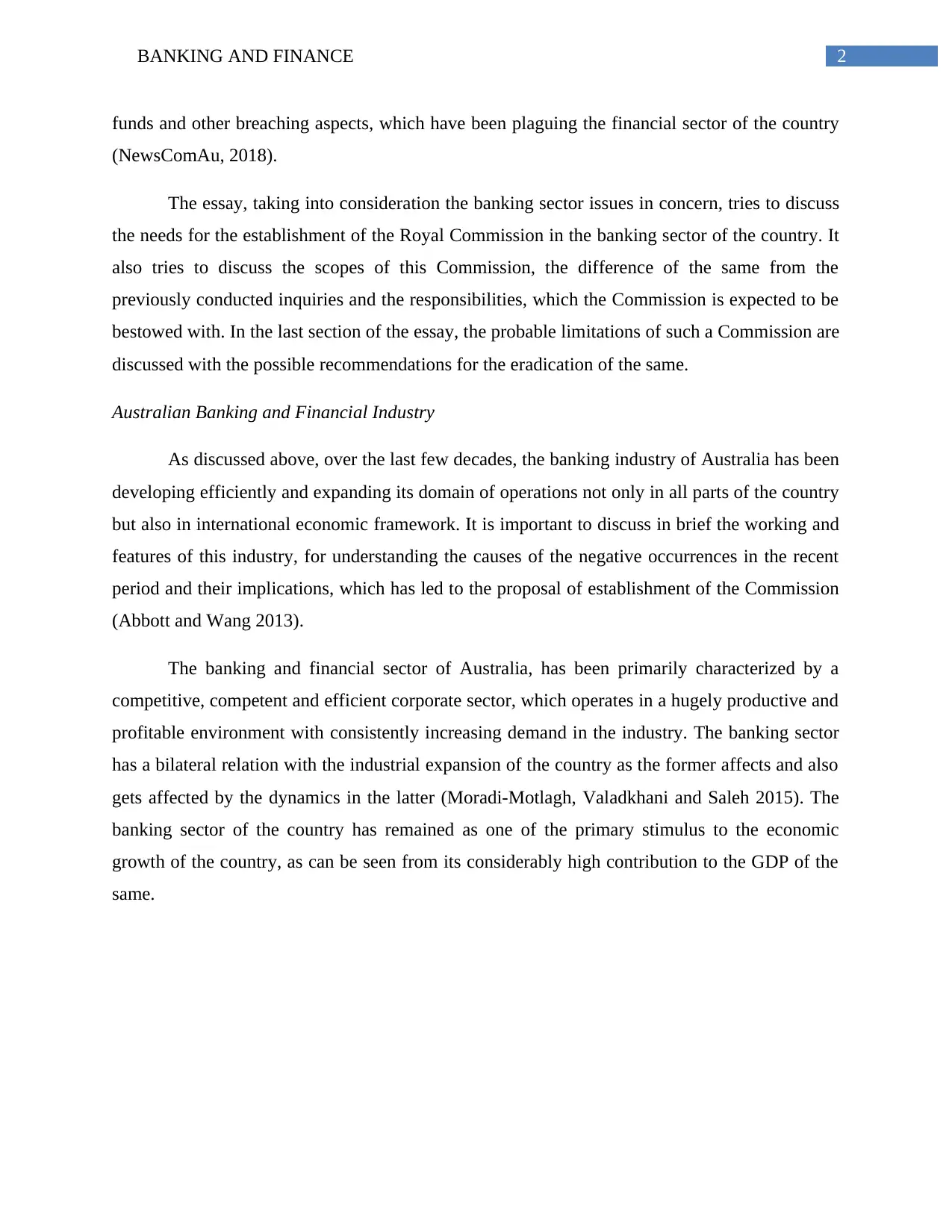
2BANKING AND FINANCE
funds and other breaching aspects, which have been plaguing the financial sector of the country
(NewsComAu, 2018).
The essay, taking into consideration the banking sector issues in concern, tries to discuss
the needs for the establishment of the Royal Commission in the banking sector of the country. It
also tries to discuss the scopes of this Commission, the difference of the same from the
previously conducted inquiries and the responsibilities, which the Commission is expected to be
bestowed with. In the last section of the essay, the probable limitations of such a Commission are
discussed with the possible recommendations for the eradication of the same.
Australian Banking and Financial Industry
As discussed above, over the last few decades, the banking industry of Australia has been
developing efficiently and expanding its domain of operations not only in all parts of the country
but also in international economic framework. It is important to discuss in brief the working and
features of this industry, for understanding the causes of the negative occurrences in the recent
period and their implications, which has led to the proposal of establishment of the Commission
(Abbott and Wang 2013).
The banking and financial sector of Australia, has been primarily characterized by a
competitive, competent and efficient corporate sector, which operates in a hugely productive and
profitable environment with consistently increasing demand in the industry. The banking sector
has a bilateral relation with the industrial expansion of the country as the former affects and also
gets affected by the dynamics in the latter (Moradi-Motlagh, Valadkhani and Saleh 2015). The
banking sector of the country has remained as one of the primary stimulus to the economic
growth of the country, as can be seen from its considerably high contribution to the GDP of the
same.
funds and other breaching aspects, which have been plaguing the financial sector of the country
(NewsComAu, 2018).
The essay, taking into consideration the banking sector issues in concern, tries to discuss
the needs for the establishment of the Royal Commission in the banking sector of the country. It
also tries to discuss the scopes of this Commission, the difference of the same from the
previously conducted inquiries and the responsibilities, which the Commission is expected to be
bestowed with. In the last section of the essay, the probable limitations of such a Commission are
discussed with the possible recommendations for the eradication of the same.
Australian Banking and Financial Industry
As discussed above, over the last few decades, the banking industry of Australia has been
developing efficiently and expanding its domain of operations not only in all parts of the country
but also in international economic framework. It is important to discuss in brief the working and
features of this industry, for understanding the causes of the negative occurrences in the recent
period and their implications, which has led to the proposal of establishment of the Commission
(Abbott and Wang 2013).
The banking and financial sector of Australia, has been primarily characterized by a
competitive, competent and efficient corporate sector, which operates in a hugely productive and
profitable environment with consistently increasing demand in the industry. The banking sector
has a bilateral relation with the industrial expansion of the country as the former affects and also
gets affected by the dynamics in the latter (Moradi-Motlagh, Valadkhani and Saleh 2015). The
banking sector of the country has remained as one of the primary stimulus to the economic
growth of the country, as can be seen from its considerably high contribution to the GDP of the
same.
⊘ This is a preview!⊘
Do you want full access?
Subscribe today to unlock all pages.

Trusted by 1+ million students worldwide
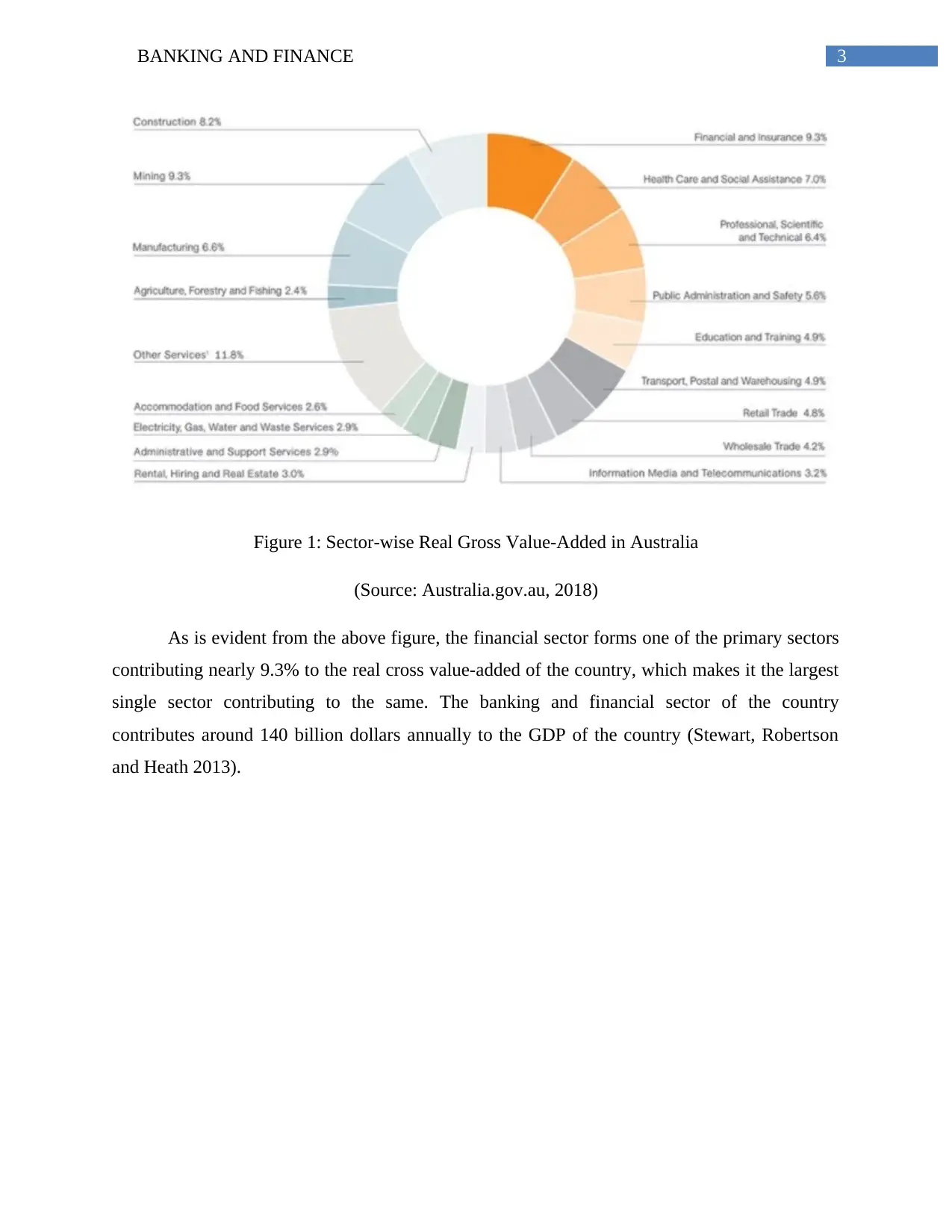
3BANKING AND FINANCE
Figure 1: Sector-wise Real Gross Value-Added in Australia
(Source: Australia.gov.au, 2018)
As is evident from the above figure, the financial sector forms one of the primary sectors
contributing nearly 9.3% to the real cross value-added of the country, which makes it the largest
single sector contributing to the same. The banking and financial sector of the country
contributes around 140 billion dollars annually to the GDP of the country (Stewart, Robertson
and Heath 2013).
Figure 1: Sector-wise Real Gross Value-Added in Australia
(Source: Australia.gov.au, 2018)
As is evident from the above figure, the financial sector forms one of the primary sectors
contributing nearly 9.3% to the real cross value-added of the country, which makes it the largest
single sector contributing to the same. The banking and financial sector of the country
contributes around 140 billion dollars annually to the GDP of the country (Stewart, Robertson
and Heath 2013).
Paraphrase This Document
Need a fresh take? Get an instant paraphrase of this document with our AI Paraphraser

4BANKING AND FINANCE
Figure 2: Employment increase by sectors in Australia
(Source: Industry.gov.au, 2018)
Apart from its robust contribution in the GDP of the country, the banking sector of the
country has also experienced increase in the employment over the years. There has been a 41%
increase in the employment in the banking sector of the country in the recent period and the
sector not employs around 450,000 people, thereby contributing significantly to the economic
growth of the country.
Recent dynamics in the banking and financial sector
The increasing industrial and commercial growth of the country in the recent periods, has
led to a significant increase in the demand for the services of the financial sector of the country.
This is primarily attributed to the fact that over the years, due to the increasing prospects, the
industrial sector of the country has been attracting considerable investments from all parts of the
globe, which has increased the activities in the banking and financial sector of the country (Allen
and Powell 2012). This can be seen from the following figure:
Figure 2: Employment increase by sectors in Australia
(Source: Industry.gov.au, 2018)
Apart from its robust contribution in the GDP of the country, the banking sector of the
country has also experienced increase in the employment over the years. There has been a 41%
increase in the employment in the banking sector of the country in the recent period and the
sector not employs around 450,000 people, thereby contributing significantly to the economic
growth of the country.
Recent dynamics in the banking and financial sector
The increasing industrial and commercial growth of the country in the recent periods, has
led to a significant increase in the demand for the services of the financial sector of the country.
This is primarily attributed to the fact that over the years, due to the increasing prospects, the
industrial sector of the country has been attracting considerable investments from all parts of the
globe, which has increased the activities in the banking and financial sector of the country (Allen
and Powell 2012). This can be seen from the following figure:
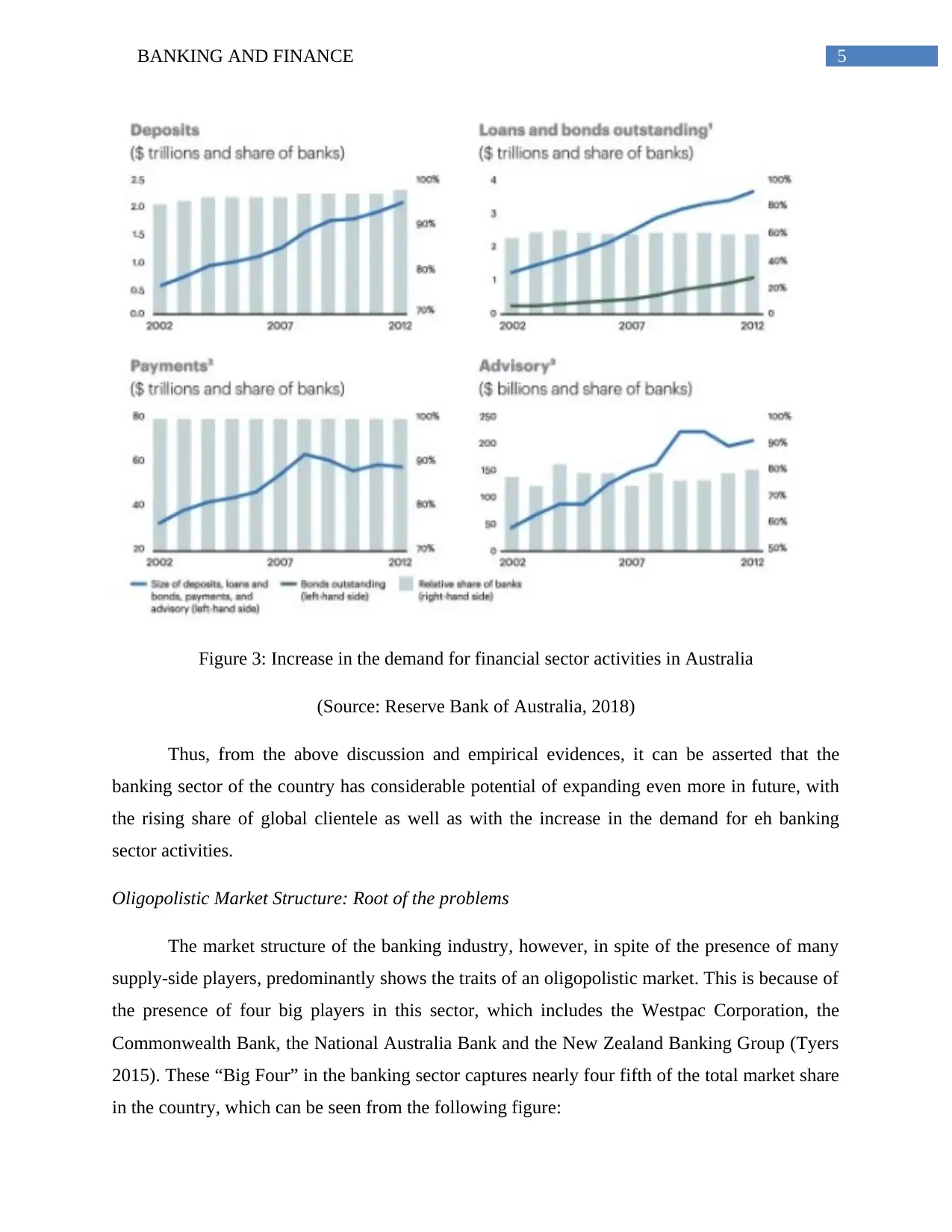
5BANKING AND FINANCE
Figure 3: Increase in the demand for financial sector activities in Australia
(Source: Reserve Bank of Australia, 2018)
Thus, from the above discussion and empirical evidences, it can be asserted that the
banking sector of the country has considerable potential of expanding even more in future, with
the rising share of global clientele as well as with the increase in the demand for eh banking
sector activities.
Oligopolistic Market Structure: Root of the problems
The market structure of the banking industry, however, in spite of the presence of many
supply-side players, predominantly shows the traits of an oligopolistic market. This is because of
the presence of four big players in this sector, which includes the Westpac Corporation, the
Commonwealth Bank, the National Australia Bank and the New Zealand Banking Group (Tyers
2015). These “Big Four” in the banking sector captures nearly four fifth of the total market share
in the country, which can be seen from the following figure:
Figure 3: Increase in the demand for financial sector activities in Australia
(Source: Reserve Bank of Australia, 2018)
Thus, from the above discussion and empirical evidences, it can be asserted that the
banking sector of the country has considerable potential of expanding even more in future, with
the rising share of global clientele as well as with the increase in the demand for eh banking
sector activities.
Oligopolistic Market Structure: Root of the problems
The market structure of the banking industry, however, in spite of the presence of many
supply-side players, predominantly shows the traits of an oligopolistic market. This is because of
the presence of four big players in this sector, which includes the Westpac Corporation, the
Commonwealth Bank, the National Australia Bank and the New Zealand Banking Group (Tyers
2015). These “Big Four” in the banking sector captures nearly four fifth of the total market share
in the country, which can be seen from the following figure:
⊘ This is a preview!⊘
Do you want full access?
Subscribe today to unlock all pages.

Trusted by 1+ million students worldwide
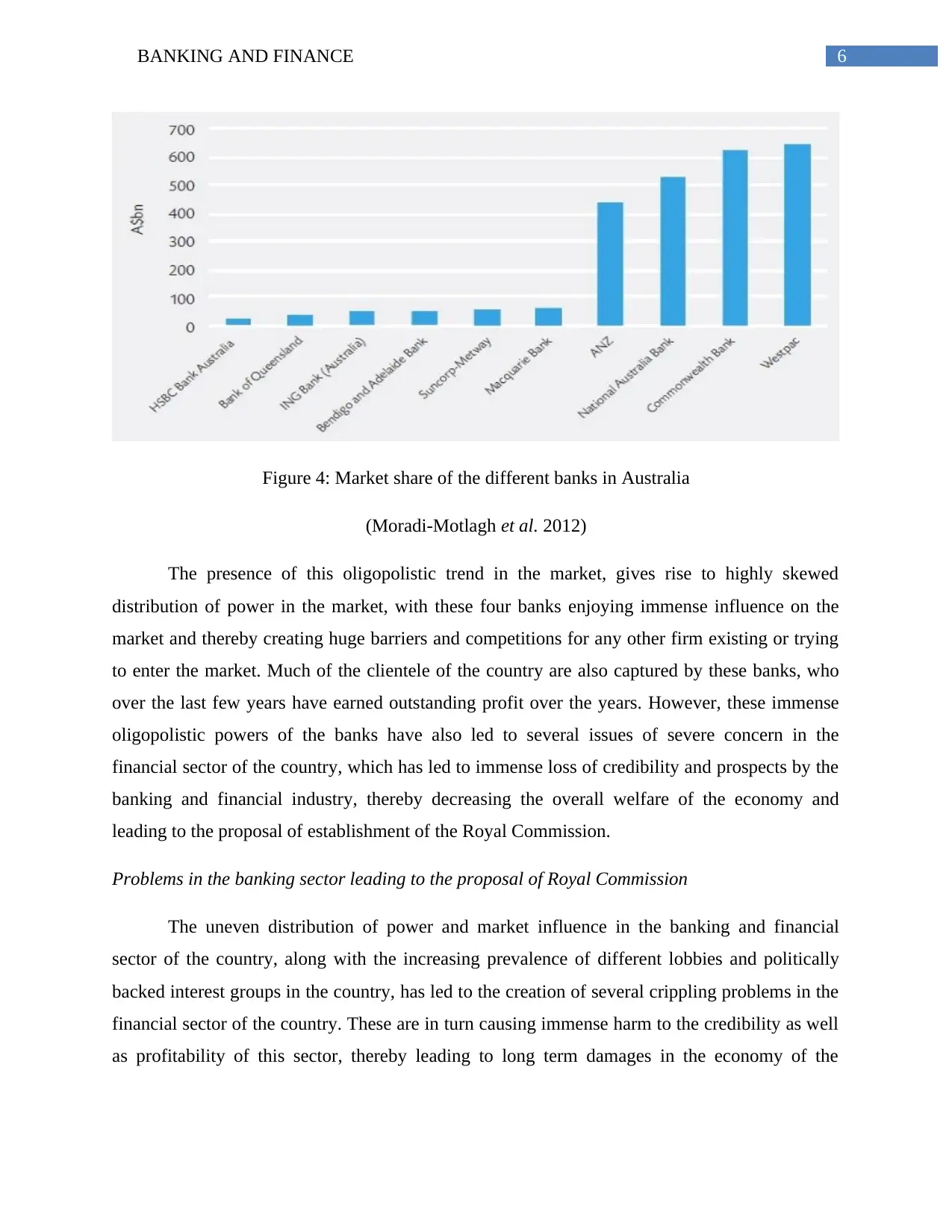
6BANKING AND FINANCE
Figure 4: Market share of the different banks in Australia
(Moradi-Motlagh et al. 2012)
The presence of this oligopolistic trend in the market, gives rise to highly skewed
distribution of power in the market, with these four banks enjoying immense influence on the
market and thereby creating huge barriers and competitions for any other firm existing or trying
to enter the market. Much of the clientele of the country are also captured by these banks, who
over the last few years have earned outstanding profit over the years. However, these immense
oligopolistic powers of the banks have also led to several issues of severe concern in the
financial sector of the country, which has led to immense loss of credibility and prospects by the
banking and financial industry, thereby decreasing the overall welfare of the economy and
leading to the proposal of establishment of the Royal Commission.
Problems in the banking sector leading to the proposal of Royal Commission
The uneven distribution of power and market influence in the banking and financial
sector of the country, along with the increasing prevalence of different lobbies and politically
backed interest groups in the country, has led to the creation of several crippling problems in the
financial sector of the country. These are in turn causing immense harm to the credibility as well
as profitability of this sector, thereby leading to long term damages in the economy of the
Figure 4: Market share of the different banks in Australia
(Moradi-Motlagh et al. 2012)
The presence of this oligopolistic trend in the market, gives rise to highly skewed
distribution of power in the market, with these four banks enjoying immense influence on the
market and thereby creating huge barriers and competitions for any other firm existing or trying
to enter the market. Much of the clientele of the country are also captured by these banks, who
over the last few years have earned outstanding profit over the years. However, these immense
oligopolistic powers of the banks have also led to several issues of severe concern in the
financial sector of the country, which has led to immense loss of credibility and prospects by the
banking and financial industry, thereby decreasing the overall welfare of the economy and
leading to the proposal of establishment of the Royal Commission.
Problems in the banking sector leading to the proposal of Royal Commission
The uneven distribution of power and market influence in the banking and financial
sector of the country, along with the increasing prevalence of different lobbies and politically
backed interest groups in the country, has led to the creation of several crippling problems in the
financial sector of the country. These are in turn causing immense harm to the credibility as well
as profitability of this sector, thereby leading to long term damages in the economy of the
Paraphrase This Document
Need a fresh take? Get an instant paraphrase of this document with our AI Paraphraser
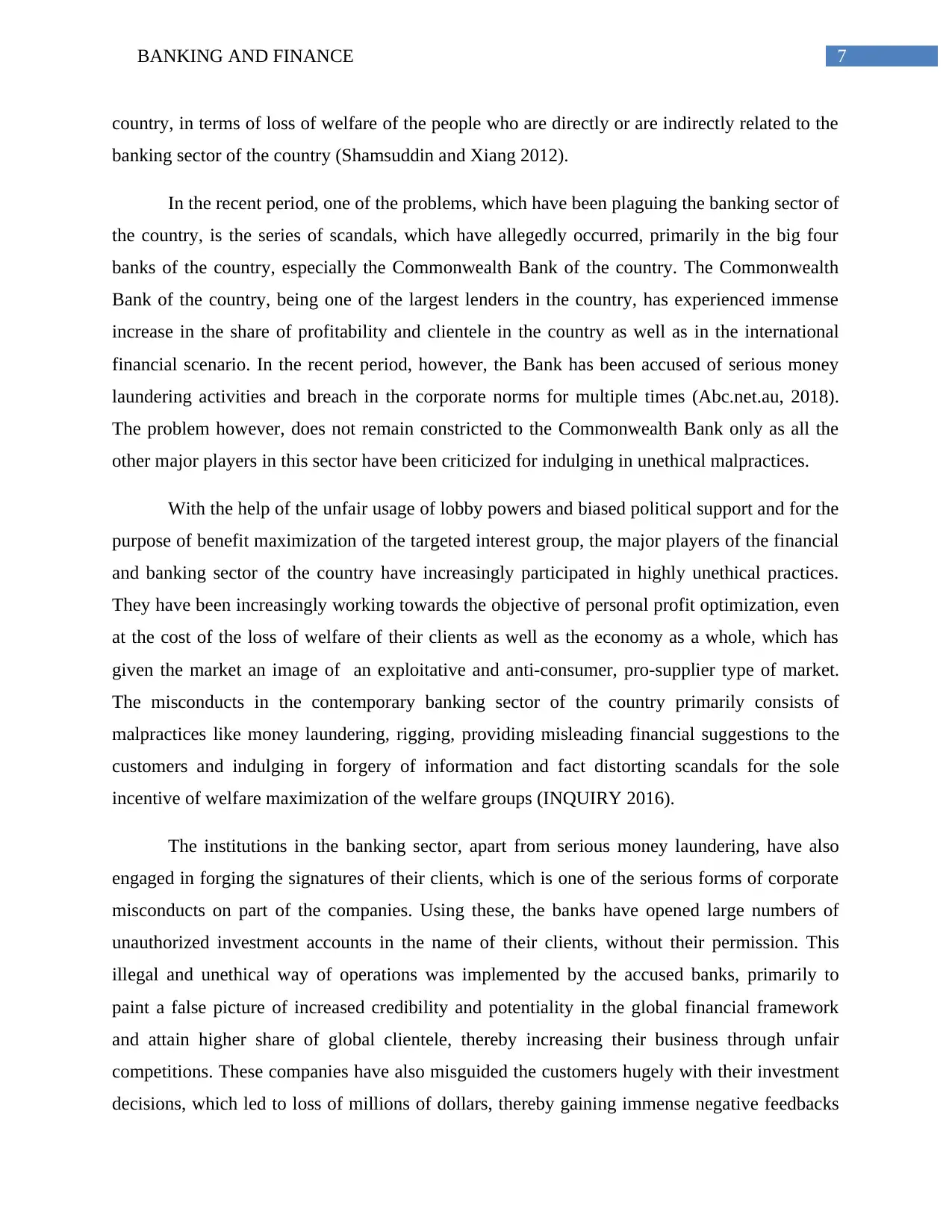
7BANKING AND FINANCE
country, in terms of loss of welfare of the people who are directly or are indirectly related to the
banking sector of the country (Shamsuddin and Xiang 2012).
In the recent period, one of the problems, which have been plaguing the banking sector of
the country, is the series of scandals, which have allegedly occurred, primarily in the big four
banks of the country, especially the Commonwealth Bank of the country. The Commonwealth
Bank of the country, being one of the largest lenders in the country, has experienced immense
increase in the share of profitability and clientele in the country as well as in the international
financial scenario. In the recent period, however, the Bank has been accused of serious money
laundering activities and breach in the corporate norms for multiple times (Abc.net.au, 2018).
The problem however, does not remain constricted to the Commonwealth Bank only as all the
other major players in this sector have been criticized for indulging in unethical malpractices.
With the help of the unfair usage of lobby powers and biased political support and for the
purpose of benefit maximization of the targeted interest group, the major players of the financial
and banking sector of the country have increasingly participated in highly unethical practices.
They have been increasingly working towards the objective of personal profit optimization, even
at the cost of the loss of welfare of their clients as well as the economy as a whole, which has
given the market an image of an exploitative and anti-consumer, pro-supplier type of market.
The misconducts in the contemporary banking sector of the country primarily consists of
malpractices like money laundering, rigging, providing misleading financial suggestions to the
customers and indulging in forgery of information and fact distorting scandals for the sole
incentive of welfare maximization of the welfare groups (INQUIRY 2016).
The institutions in the banking sector, apart from serious money laundering, have also
engaged in forging the signatures of their clients, which is one of the serious forms of corporate
misconducts on part of the companies. Using these, the banks have opened large numbers of
unauthorized investment accounts in the name of their clients, without their permission. This
illegal and unethical way of operations was implemented by the accused banks, primarily to
paint a false picture of increased credibility and potentiality in the global financial framework
and attain higher share of global clientele, thereby increasing their business through unfair
competitions. These companies have also misguided the customers hugely with their investment
decisions, which led to loss of millions of dollars, thereby gaining immense negative feedbacks
country, in terms of loss of welfare of the people who are directly or are indirectly related to the
banking sector of the country (Shamsuddin and Xiang 2012).
In the recent period, one of the problems, which have been plaguing the banking sector of
the country, is the series of scandals, which have allegedly occurred, primarily in the big four
banks of the country, especially the Commonwealth Bank of the country. The Commonwealth
Bank of the country, being one of the largest lenders in the country, has experienced immense
increase in the share of profitability and clientele in the country as well as in the international
financial scenario. In the recent period, however, the Bank has been accused of serious money
laundering activities and breach in the corporate norms for multiple times (Abc.net.au, 2018).
The problem however, does not remain constricted to the Commonwealth Bank only as all the
other major players in this sector have been criticized for indulging in unethical malpractices.
With the help of the unfair usage of lobby powers and biased political support and for the
purpose of benefit maximization of the targeted interest group, the major players of the financial
and banking sector of the country have increasingly participated in highly unethical practices.
They have been increasingly working towards the objective of personal profit optimization, even
at the cost of the loss of welfare of their clients as well as the economy as a whole, which has
given the market an image of an exploitative and anti-consumer, pro-supplier type of market.
The misconducts in the contemporary banking sector of the country primarily consists of
malpractices like money laundering, rigging, providing misleading financial suggestions to the
customers and indulging in forgery of information and fact distorting scandals for the sole
incentive of welfare maximization of the welfare groups (INQUIRY 2016).
The institutions in the banking sector, apart from serious money laundering, have also
engaged in forging the signatures of their clients, which is one of the serious forms of corporate
misconducts on part of the companies. Using these, the banks have opened large numbers of
unauthorized investment accounts in the name of their clients, without their permission. This
illegal and unethical way of operations was implemented by the accused banks, primarily to
paint a false picture of increased credibility and potentiality in the global financial framework
and attain higher share of global clientele, thereby increasing their business through unfair
competitions. These companies have also misguided the customers hugely with their investment
decisions, which led to loss of millions of dollars, thereby gaining immense negative feedbacks

8BANKING AND FINANCE
for the company (Batrouney 2016). The unrest reached its pinnacle with the collapse of the
WestPoint property developers, who went bankrupt falling prey to the corruptions in the banking
sector. The loss was as high as $388 million and affected the welfare of nearly 4,300 investors.
This, along with the overall negative implications in the financial sector led to immense
loss of welfare of the clientele, thereby increasing the unrest and decreasing the lack of
credibility of the sector, which was seen from their falling share values and the drain of wealth
and investment outside the country.
Figure 5: Disappointing share values of the banks in Australia (Since 2007)
(Source: Jacobs 2018)
In spite of several earlier inquiries, there has not been any such reform in the conditions
of the contemporary banking sector of the country, which in its turn led to the need for
implementation of an enabled, unbiased and capable investigating body especially for these
issues, which in turn led to the proposal of establishment of the Royal Commission.
for the company (Batrouney 2016). The unrest reached its pinnacle with the collapse of the
WestPoint property developers, who went bankrupt falling prey to the corruptions in the banking
sector. The loss was as high as $388 million and affected the welfare of nearly 4,300 investors.
This, along with the overall negative implications in the financial sector led to immense
loss of welfare of the clientele, thereby increasing the unrest and decreasing the lack of
credibility of the sector, which was seen from their falling share values and the drain of wealth
and investment outside the country.
Figure 5: Disappointing share values of the banks in Australia (Since 2007)
(Source: Jacobs 2018)
In spite of several earlier inquiries, there has not been any such reform in the conditions
of the contemporary banking sector of the country, which in its turn led to the need for
implementation of an enabled, unbiased and capable investigating body especially for these
issues, which in turn led to the proposal of establishment of the Royal Commission.
⊘ This is a preview!⊘
Do you want full access?
Subscribe today to unlock all pages.

Trusted by 1+ million students worldwide
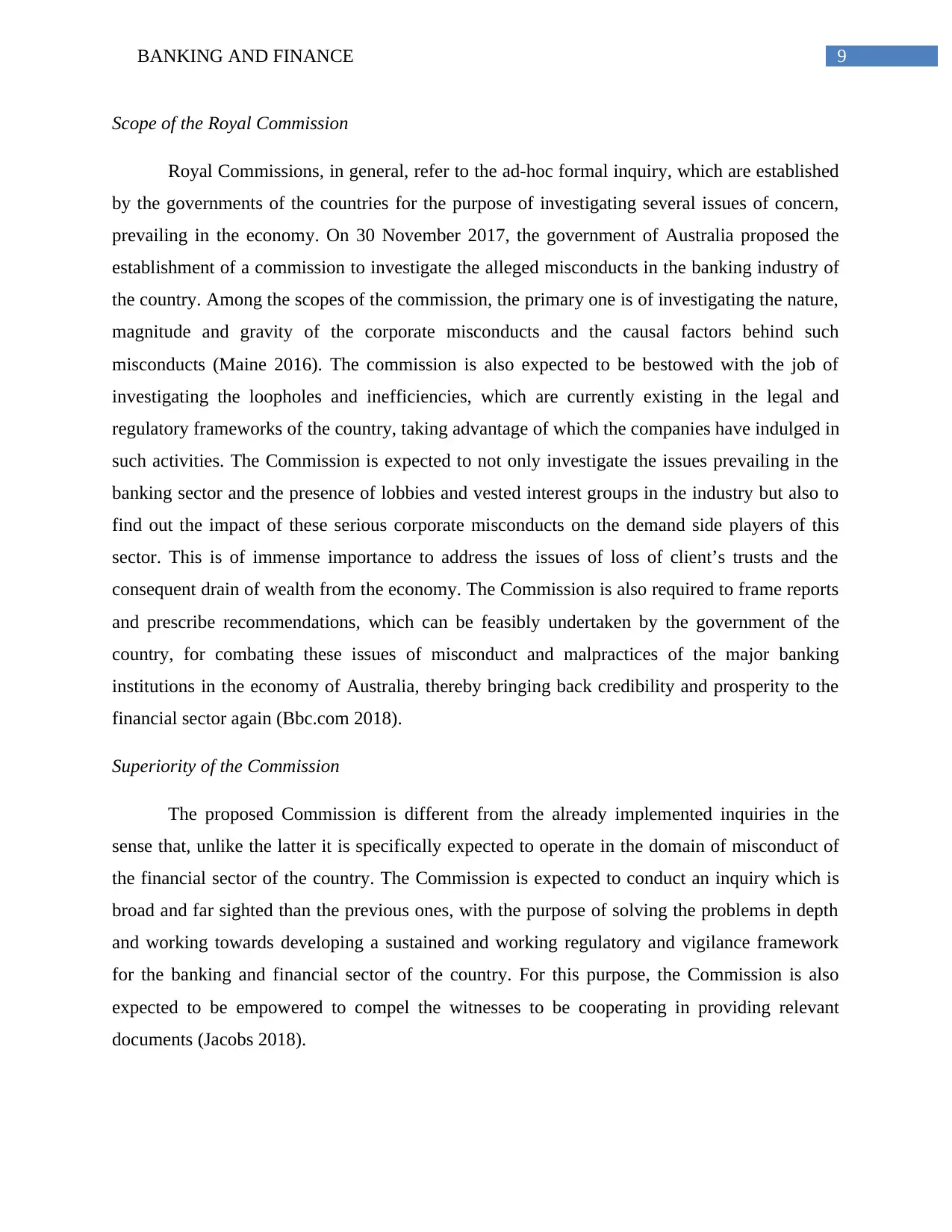
9BANKING AND FINANCE
Scope of the Royal Commission
Royal Commissions, in general, refer to the ad-hoc formal inquiry, which are established
by the governments of the countries for the purpose of investigating several issues of concern,
prevailing in the economy. On 30 November 2017, the government of Australia proposed the
establishment of a commission to investigate the alleged misconducts in the banking industry of
the country. Among the scopes of the commission, the primary one is of investigating the nature,
magnitude and gravity of the corporate misconducts and the causal factors behind such
misconducts (Maine 2016). The commission is also expected to be bestowed with the job of
investigating the loopholes and inefficiencies, which are currently existing in the legal and
regulatory frameworks of the country, taking advantage of which the companies have indulged in
such activities. The Commission is expected to not only investigate the issues prevailing in the
banking sector and the presence of lobbies and vested interest groups in the industry but also to
find out the impact of these serious corporate misconducts on the demand side players of this
sector. This is of immense importance to address the issues of loss of client’s trusts and the
consequent drain of wealth from the economy. The Commission is also required to frame reports
and prescribe recommendations, which can be feasibly undertaken by the government of the
country, for combating these issues of misconduct and malpractices of the major banking
institutions in the economy of Australia, thereby bringing back credibility and prosperity to the
financial sector again (Bbc.com 2018).
Superiority of the Commission
The proposed Commission is different from the already implemented inquiries in the
sense that, unlike the latter it is specifically expected to operate in the domain of misconduct of
the financial sector of the country. The Commission is expected to conduct an inquiry which is
broad and far sighted than the previous ones, with the purpose of solving the problems in depth
and working towards developing a sustained and working regulatory and vigilance framework
for the banking and financial sector of the country. For this purpose, the Commission is also
expected to be empowered to compel the witnesses to be cooperating in providing relevant
documents (Jacobs 2018).
Scope of the Royal Commission
Royal Commissions, in general, refer to the ad-hoc formal inquiry, which are established
by the governments of the countries for the purpose of investigating several issues of concern,
prevailing in the economy. On 30 November 2017, the government of Australia proposed the
establishment of a commission to investigate the alleged misconducts in the banking industry of
the country. Among the scopes of the commission, the primary one is of investigating the nature,
magnitude and gravity of the corporate misconducts and the causal factors behind such
misconducts (Maine 2016). The commission is also expected to be bestowed with the job of
investigating the loopholes and inefficiencies, which are currently existing in the legal and
regulatory frameworks of the country, taking advantage of which the companies have indulged in
such activities. The Commission is expected to not only investigate the issues prevailing in the
banking sector and the presence of lobbies and vested interest groups in the industry but also to
find out the impact of these serious corporate misconducts on the demand side players of this
sector. This is of immense importance to address the issues of loss of client’s trusts and the
consequent drain of wealth from the economy. The Commission is also required to frame reports
and prescribe recommendations, which can be feasibly undertaken by the government of the
country, for combating these issues of misconduct and malpractices of the major banking
institutions in the economy of Australia, thereby bringing back credibility and prosperity to the
financial sector again (Bbc.com 2018).
Superiority of the Commission
The proposed Commission is different from the already implemented inquiries in the
sense that, unlike the latter it is specifically expected to operate in the domain of misconduct of
the financial sector of the country. The Commission is expected to conduct an inquiry which is
broad and far sighted than the previous ones, with the purpose of solving the problems in depth
and working towards developing a sustained and working regulatory and vigilance framework
for the banking and financial sector of the country. For this purpose, the Commission is also
expected to be empowered to compel the witnesses to be cooperating in providing relevant
documents (Jacobs 2018).
Paraphrase This Document
Need a fresh take? Get an instant paraphrase of this document with our AI Paraphraser
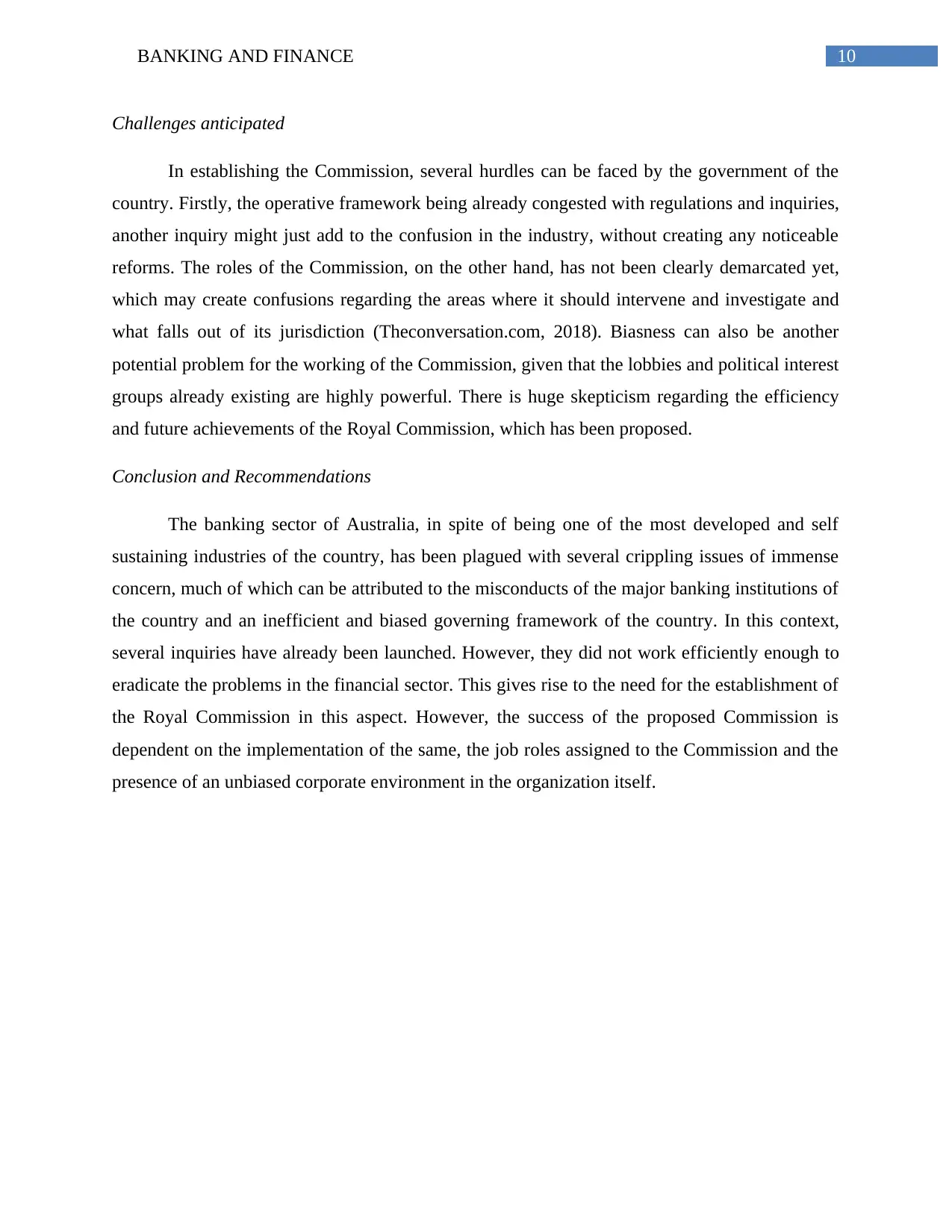
10BANKING AND FINANCE
Challenges anticipated
In establishing the Commission, several hurdles can be faced by the government of the
country. Firstly, the operative framework being already congested with regulations and inquiries,
another inquiry might just add to the confusion in the industry, without creating any noticeable
reforms. The roles of the Commission, on the other hand, has not been clearly demarcated yet,
which may create confusions regarding the areas where it should intervene and investigate and
what falls out of its jurisdiction (Theconversation.com, 2018). Biasness can also be another
potential problem for the working of the Commission, given that the lobbies and political interest
groups already existing are highly powerful. There is huge skepticism regarding the efficiency
and future achievements of the Royal Commission, which has been proposed.
Conclusion and Recommendations
The banking sector of Australia, in spite of being one of the most developed and self
sustaining industries of the country, has been plagued with several crippling issues of immense
concern, much of which can be attributed to the misconducts of the major banking institutions of
the country and an inefficient and biased governing framework of the country. In this context,
several inquiries have already been launched. However, they did not work efficiently enough to
eradicate the problems in the financial sector. This gives rise to the need for the establishment of
the Royal Commission in this aspect. However, the success of the proposed Commission is
dependent on the implementation of the same, the job roles assigned to the Commission and the
presence of an unbiased corporate environment in the organization itself.
Challenges anticipated
In establishing the Commission, several hurdles can be faced by the government of the
country. Firstly, the operative framework being already congested with regulations and inquiries,
another inquiry might just add to the confusion in the industry, without creating any noticeable
reforms. The roles of the Commission, on the other hand, has not been clearly demarcated yet,
which may create confusions regarding the areas where it should intervene and investigate and
what falls out of its jurisdiction (Theconversation.com, 2018). Biasness can also be another
potential problem for the working of the Commission, given that the lobbies and political interest
groups already existing are highly powerful. There is huge skepticism regarding the efficiency
and future achievements of the Royal Commission, which has been proposed.
Conclusion and Recommendations
The banking sector of Australia, in spite of being one of the most developed and self
sustaining industries of the country, has been plagued with several crippling issues of immense
concern, much of which can be attributed to the misconducts of the major banking institutions of
the country and an inefficient and biased governing framework of the country. In this context,
several inquiries have already been launched. However, they did not work efficiently enough to
eradicate the problems in the financial sector. This gives rise to the need for the establishment of
the Royal Commission in this aspect. However, the success of the proposed Commission is
dependent on the implementation of the same, the job roles assigned to the Commission and the
presence of an unbiased corporate environment in the organization itself.
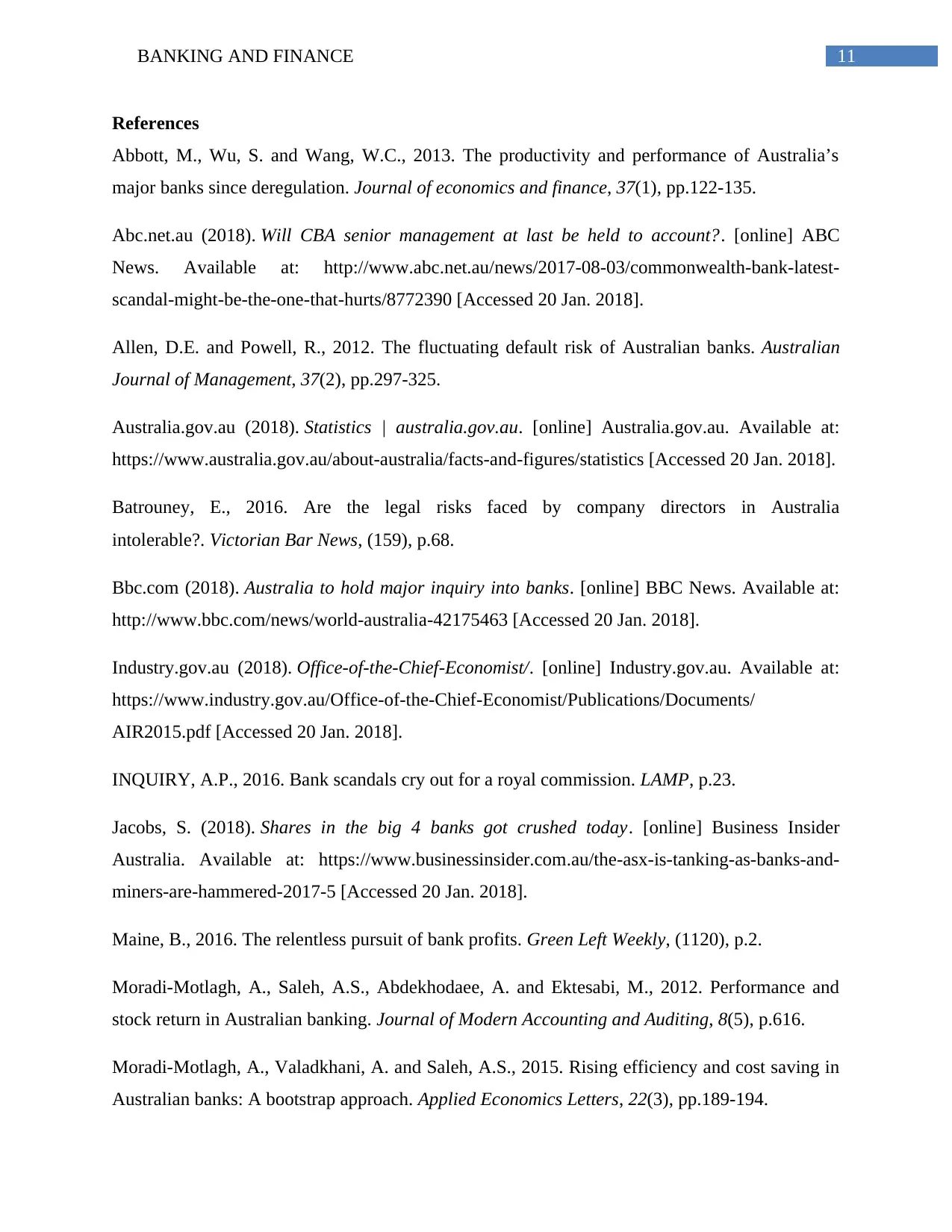
11BANKING AND FINANCE
References
Abbott, M., Wu, S. and Wang, W.C., 2013. The productivity and performance of Australia’s
major banks since deregulation. Journal of economics and finance, 37(1), pp.122-135.
Abc.net.au (2018). Will CBA senior management at last be held to account?. [online] ABC
News. Available at: http://www.abc.net.au/news/2017-08-03/commonwealth-bank-latest-
scandal-might-be-the-one-that-hurts/8772390 [Accessed 20 Jan. 2018].
Allen, D.E. and Powell, R., 2012. The fluctuating default risk of Australian banks. Australian
Journal of Management, 37(2), pp.297-325.
Australia.gov.au (2018). Statistics | australia.gov.au. [online] Australia.gov.au. Available at:
https://www.australia.gov.au/about-australia/facts-and-figures/statistics [Accessed 20 Jan. 2018].
Batrouney, E., 2016. Are the legal risks faced by company directors in Australia
intolerable?. Victorian Bar News, (159), p.68.
Bbc.com (2018). Australia to hold major inquiry into banks. [online] BBC News. Available at:
http://www.bbc.com/news/world-australia-42175463 [Accessed 20 Jan. 2018].
Industry.gov.au (2018). Office-of-the-Chief-Economist/. [online] Industry.gov.au. Available at:
https://www.industry.gov.au/Office-of-the-Chief-Economist/Publications/Documents/
AIR2015.pdf [Accessed 20 Jan. 2018].
INQUIRY, A.P., 2016. Bank scandals cry out for a royal commission. LAMP, p.23.
Jacobs, S. (2018). Shares in the big 4 banks got crushed today. [online] Business Insider
Australia. Available at: https://www.businessinsider.com.au/the-asx-is-tanking-as-banks-and-
miners-are-hammered-2017-5 [Accessed 20 Jan. 2018].
Maine, B., 2016. The relentless pursuit of bank profits. Green Left Weekly, (1120), p.2.
Moradi-Motlagh, A., Saleh, A.S., Abdekhodaee, A. and Ektesabi, M., 2012. Performance and
stock return in Australian banking. Journal of Modern Accounting and Auditing, 8(5), p.616.
Moradi-Motlagh, A., Valadkhani, A. and Saleh, A.S., 2015. Rising efficiency and cost saving in
Australian banks: A bootstrap approach. Applied Economics Letters, 22(3), pp.189-194.
References
Abbott, M., Wu, S. and Wang, W.C., 2013. The productivity and performance of Australia’s
major banks since deregulation. Journal of economics and finance, 37(1), pp.122-135.
Abc.net.au (2018). Will CBA senior management at last be held to account?. [online] ABC
News. Available at: http://www.abc.net.au/news/2017-08-03/commonwealth-bank-latest-
scandal-might-be-the-one-that-hurts/8772390 [Accessed 20 Jan. 2018].
Allen, D.E. and Powell, R., 2012. The fluctuating default risk of Australian banks. Australian
Journal of Management, 37(2), pp.297-325.
Australia.gov.au (2018). Statistics | australia.gov.au. [online] Australia.gov.au. Available at:
https://www.australia.gov.au/about-australia/facts-and-figures/statistics [Accessed 20 Jan. 2018].
Batrouney, E., 2016. Are the legal risks faced by company directors in Australia
intolerable?. Victorian Bar News, (159), p.68.
Bbc.com (2018). Australia to hold major inquiry into banks. [online] BBC News. Available at:
http://www.bbc.com/news/world-australia-42175463 [Accessed 20 Jan. 2018].
Industry.gov.au (2018). Office-of-the-Chief-Economist/. [online] Industry.gov.au. Available at:
https://www.industry.gov.au/Office-of-the-Chief-Economist/Publications/Documents/
AIR2015.pdf [Accessed 20 Jan. 2018].
INQUIRY, A.P., 2016. Bank scandals cry out for a royal commission. LAMP, p.23.
Jacobs, S. (2018). Shares in the big 4 banks got crushed today. [online] Business Insider
Australia. Available at: https://www.businessinsider.com.au/the-asx-is-tanking-as-banks-and-
miners-are-hammered-2017-5 [Accessed 20 Jan. 2018].
Maine, B., 2016. The relentless pursuit of bank profits. Green Left Weekly, (1120), p.2.
Moradi-Motlagh, A., Saleh, A.S., Abdekhodaee, A. and Ektesabi, M., 2012. Performance and
stock return in Australian banking. Journal of Modern Accounting and Auditing, 8(5), p.616.
Moradi-Motlagh, A., Valadkhani, A. and Saleh, A.S., 2015. Rising efficiency and cost saving in
Australian banks: A bootstrap approach. Applied Economics Letters, 22(3), pp.189-194.
⊘ This is a preview!⊘
Do you want full access?
Subscribe today to unlock all pages.

Trusted by 1+ million students worldwide
1 out of 13
Related Documents
Your All-in-One AI-Powered Toolkit for Academic Success.
+13062052269
info@desklib.com
Available 24*7 on WhatsApp / Email
![[object Object]](/_next/static/media/star-bottom.7253800d.svg)
Unlock your academic potential
Copyright © 2020–2025 A2Z Services. All Rights Reserved. Developed and managed by ZUCOL.





